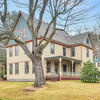Bottomless bounty | Scarborough's DeadHead Lumber finds new markets for old, sunken logs
A set of metal tongs looms in the foreground above a gray moon-like landscape displayed on the boat’s tiny black-and-white monitor. In the background emerges a long, thin shadow, giving depth to a cylindrical shape. To the casual observer, it looks like just another old log, one of millions that litter the floors of Maine’s lakes and rivers. But to Todd Morrissette, it’s sunken treasure.
Story continues after slideshow
Morrissette, watching the screen, his hands on a set of controls, positions the metal tongs above what he’s sure is a yellow birch log. He quickly lowers them and the tongs strike the log, sending up a gray cloud of sediment on the screen. But it’s a glancing blow and the tongs slide off. “The ones that have been down here a really long time don’t have any bark left on them and they’re extremely slimy,” Morrissette says, his eyes still glued to his screen, his hands working the controls to reposition the tongs. “Sometimes you have to grab them a few times in order to get the tongs to stick.”
Morrissette, 39, is standing in the pilothouse of Aqua-logger, the pontoon boat he specifically designed to salvage logs from the bottom of lakes and ponds. It’s his office during the summer months, when he scours Moosehead Lake with his sonar looking for sunken logs, also called deadheads, which, for some, last saw the light of day 150 years ago during log drives on the lake.
This morning in early July, Morrissette, who founded DeadHead Lumber in April 2008, is working at a spot off the western shore of Moosehead Lake’s Sugar Island where logs cut from the island were floated to a plywood mill on the southern end of the lake. Hardwoods like birch do not float, so loggers built rafts of buoyant softwoods like spruce and piled the hardwoods on top. Some of the logs never made it to the mill. On the journey, bad weather could create waves as high as 4 feet that would break apart the rafts, sending thousands of hardwood logs to the bottom of the lake where the lack of oxygen and sunlight preserved them. It’s mostly those unique, yellow birch logs that Morrissette is salvaging this summer.
The typical hardwood log harvested from today’s forests averages between 12 and 14 inches in diameter. Morrissette’s deadheads average between 18 and 20 inches, with the largest being 36 inches in diameter. “You can’t find that now,” he says.
Once he gets the logs up, Morrissette mills them into rough planks, then dries and sells them to flooring companies or high-end cabinetmakers. Since the logs are old growth, planks can sell for as much as 20 times the amount per board foot of logs cut today. Old growth birch grew slowly in the shade of pines and spruce over 100 years, and therefore have fewer blemishes and knots and tighter growth rings. “When you have tight rings, it makes the wood more stable, harder, denser,” Morrissette says.
Plus, the logs Morrissette reclaims from the bottoms of Maine’s lakes weren’t cut from today’s forests, an appealing pedigree to green-conscious consumers.
Marc Poirier, owner of Longleaf Lumber, which specializes in reclaimed lumber and operates a mill in Berwick, purchased 10,000 board feet of rough planks from Morrissette to sell as flooring. He sold out quickly because, he says, the wood is high-grade and his customers value unique wood with a past. “People are increasingly conscious of what it is to fell trees and produce new trees,” Poirier says. “A lot of people think exotic wood needs to come from exotic places, but nothing could be farther from the truth. You don’t need to ship from Brazil where they’re clear-cutting the rain forest.”
After years spent traveling to various mills in China buying hardwood flooring for his former Portland employer, PanTim Wood Products, Morrissette wanted to try something new. China “doesn’t have a stick of wood,” Morrissette says, but is one of the largest producers of hardwood floors in the world through its use of imported materials. That inefficient supply chain didn’t seem right to him, so he pursued his salvage business because it “was green and eco-friendly and I get to work on a boat all day.”
Choppy regulatory waters
People have been salvaging logs from the bottom of Moosehead Lake for at least 60 years, and there are salvaging operations on the Great Lakes and in the South, Morrissette says. But DeadHead Lumber, based in Scarborough, is the only current commercial operation he knows of in Maine.
There are no firm estimates for how much timber lies in wait in Maine’s bodies of water, but billions of logs were sent down waterways to sawmills and later paper mills. Even if only a small percentage sunk, it means there are millions of deadheads in Maine. “I have no idea as far as estimates in the lakes,” Morrissette says. “All I know is enough to keep me happy for a long time.”
Once he hauls them out of the water, Morrissette needs to transport the retrieved logs to a mill within three days to be cut into planks, after which they’re transported to a warehouse in Scarborough and slowly air dried. The logs’ moisture content is so high that the logs will split if they’re left to dry on their own, and they would “basically blow apart” if they were dried too quickly in kilns, Morrissette says. “If you don’t know how to dry it properly you could end up with 50,000 feet of firewood.”
Until recently, deadhead salvaging was unregulated. But in 1999, the state claimed ownership of all submerged logs in Maine and now requires salvage operators to buy the logs from the state. Two state employees meet Morrissette every time he loads a truck with his deadheads to determine how much to charge him for his bounty. Morrissette pays the state 20% of the mill delivered value of each log.
State oversight also means paperwork. His first year, it took Morrissette almost six months to get the permits to allow him to begin his salvage operations on Moosehead Lake. “It’s a huge bureaucracy,” Morrissette says. “It takes longer to get permitted than it does to conduct the salvaging.”
Permits from the Bureau of Parks and Lands have to be signed off by the Department of Environmental Protection, the U.S. Army Corps of Engineers, the Maine Historic Preservation Commission and the Department of Inland Fisheries and Wildlife. Additionally, a permit from the local zoning agency or Land Use Regulation Commission is needed. The permits are good for only one year.
This year, Morrissette asked for a five-year permit. “One year old, a little wiser,” he says with a laugh as he drives his boat down the west side of Sugar Island toward his landing. The four salvaged logs tied to the side of the boat could each bring roughly $1,200.
The permitting process needs to be repeated for every body of water where Morrissette wants to salvage. He spent last fall and this spring screening other lakes and found some promising sites, including the Rangeley Lakes. This fall, he’ll work on the permits for those other lakes. “I’m set for three to four years in advance. I already know what I’m going to pick and where it is,” Morrissette says.
The state limits the amount of timber that can be salvaged by one operator to 125,000 board feet a year. Morrissette salvaged 50,000 board feet last summer, but expects to meet the limit this year. That’s one regulation Morrissette welcomes.
“It kind of helps,” he says. “I’m a small operation. If there was no limit and somebody found a good market for this wood like I’ve done, a large company could come in and wipe out the resource in an extremely short period of time and flood the market with this recovered wood and drive the prices down.”
Flooring, furniture and finances
Morrissette spent about $500,000 initially to build his boat, get permits, conduct last summer’s salvage and do some marketing, which he financed personally. It was more than he expected, but says, “Once you get into it for a certain amount, you have to keep going and see it through.”
That first year was also difficult because he had no cash flow until after he salvaged, milled and dried the logs. “So you’re not making money for a while,” he says.
Morrissette worked all winter lining up customers. In March, he finally began to generate income. By July, he had sold off 80% of last year’s salvage for revenue of about $300,000.
Poirier from Longleaf Lumber says red oak flooring can be bought for $0.30 per board foot, while Morrissette’s goal is to sell his old-growth yellow birch flooring for between $6 and $20 per board foot. “The only thing they have in common is they’re both wood,” Poirier says.
This year, Morrissette has product in every stage of production, from freshly salvaged logs to rough planks that will be sold wholesale to companies like Longleaf Lumber and retail-ready flooring that Morrissette is milling himself. About 20% of his business is flooring he’s milled himself, including a small amount sold to homeowners and contractors refurbishing or building homes in Maine. He’d like to grow that part of his business and offer customers reclaimed oak and pine he’d buy from salvagers in the South. But selling the rough planks is still his “bread and butter,” he says.
Morrissette initially thought there would be demand for his high-grade wood from high-end furniture businesses. It hasn’t turned out that way. Currently, 90% of his product is going into floors, mostly via Canadian companies. But he says the furniture side of his business is building.
Peter Korn, executive director of the Center for Furniture Craftsmanship in Rockport, says he doesn’t know any high-end furniture makers who specialize in using old growth wood, but he does see the attraction. “People do love wood that has a story behind it,” he says. “Suddenly it’s not just a random piece of material that found its way to a lumberyard. It brings its own meaning to a piece of work you create with it — that alone counts for a lot.”
Morrissette has some stories of his own. He’s weathered storms that have created 5-foot waves in the middle of the lake, making the logs tied to the side of his boat more like battering rams than reclaimed treasure. One time, “I grabbed a knife and cut them all loose and went home after eight or 10 hours of work without anything and came back this year and salvaged them all again during better weather.”
Morrissette had to cut his bounty loose three times last summer, but he doesn’t let it discourage him. He sees the irony. “That’s how they got there in the first place,” he says.
Whit Richardson, Mainebiz new media editor, can be reached at wrichardson@mainebiz.biz.










Comments